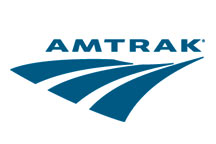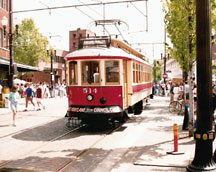A couple of weeks ago, Gary Sandberg suggested the city should come up with a strategy for the Kellar Branch before the Surface Transportation Board (STB) tells the city what to do. Toward that end, the council agreed to ask staff to bring back their options and recommendations on what to do.
Well, that information is on the agenda for Tuesday night’s (2/6/07) council meeting. However, this communication from city staff omits important, germane facts that the council should be considering.
Here’s what the communication says:
Option 1 – Deferral: It is possible for the Council to defer this matter to February 13 because of the STB Continuance. Council could even continue this to February 20 if it looks as though a resolution may be reached. If this option is chosen, the Council may want to consider formally requesting positions from ClRY and PlRY for its consideration. Both have been invited to put their position in writing, but neither has done so as of February 1, 2007.
That is untrue. As I reported back in May 2006, Pioneer has had their “position” in writing since September 24, 2004. The president of Pioneer Railcorp, J. Michael Carr, explained his company’s position thus:
We are fighting this battle because Pioneer is a Peoria company, dedicated to the betterment of this community. Abandonment of the Kellar Branch would be an incredibly short-sighted move, for which this City would suffer for decades to come. We are determined not to let that happen.
This City Council has been able to put petty politics aside and make some hard decisions for the long-term benefit of Peoria. It is time to do that again. While it may not be popular with a few newspaper editors, bringing the saga of the Kellar Branch to an end is the right thing to do for the City. It will return almost a million dollars to the City immediately, and bring dividends for many years to come. I am hopeful the Council will exercise the statesmanship to act on this opportunity.
Did you catch that? They’re dedicated to the betterment of this community because they are a Peoria company. Many people forget that Pioneer is a local company (CIRY is based out of LaSalle and the Kellar Branch is the only interest they have in our area), and they also forget that its founder, Guy Brenkman, is not the President anymore — hasn’t been for years (not that it should matter, but it does to some people).
Pioneer’s offer still stands. (Read the full text here.) To put their money where their mouth is regarding commitment to the Peoria area, check out some of the things they’ve offered:
- Purchase the Kellar Branch and western spur from the City of Peoria for $565,000, or accept a long-term lease on the lines;
- Grant the Park District a 999-year lease on a portion of the right-of-way for the use of a trail;
- Donate up to $100,000 in in-kind services (railcar usage, train service, equipment use, flagging and other labor services) to the Park District to assist in the construction of said trail;
- Work with the Park District to provide for joint use of the right-of-way, including the joint use of existing bridges;
- Provide the labor, materials and equipment to construct a trestle for the trail to traverse the section behind Versailles Garden where the track elevation has caused the Park District the most concern (the Park District estimates this item alone would cost almost $400,000);
- Upgrade the Kellar Branch track to Federal Railroad Administration (FRA) “Class I†standards;
- Aggressively seek new business in Pioneer Park and Growth Cell Two;
- Develop a “dinner train†as a tourist attraction for the city (similar to a successful dinner train Pioneer runs on their Gettysburg & Northern Railroad);
- Develop, in cooperation with the city, tourist/commuter service from downtown (the Illinois Prairie Railroad Foundation has submitted a plan for providing this service recently);
- Pursue the establishment of a “railroad academy†in partnership with Illinois Central College and/or other appropriate partners, to train students in train operation and maintenance, using Pioneer’s equipment and facilities; and
- Give the city right of first refusal to repurchase the line if another entity wants to buy it from Pioneer.
What has CIRY offered to the area? Hmmm….. nothing. Next option from the city:
Option 2 -Sale of Kellar Branch: The City could choose to sell its ownership of the Kellar Branch which, of course, would have limited value without the Village of Peoria Heights agreeing to sell its portion of the Kellar Branch. In the past, PlRY has expressed interest in purchasing the Kellar Branch. The sale of the Kellar Branch would make the possibility of a recreational trail a more remote possibility. The sale would not require STB approval.
There are several problems with this. First, “PIRY [Pioneer] has expressed interest in purchasing the Kellar Branch.” In light of their offer, I’d say this is the understatement of 2007 so far. Also, saying that selling the branch “would make … a recreational trail a more remote possibility” is exactly the opposite of the truth. It makes it more of a possibility — a promise to cooperate, a promise to provide money and manpower, and a promise of signing a lease agreement. Not selling it and having CIRY run it would make trail usage more remote.
But the most baffling part of the comment is the first part: that owning the City’s portion of the Kellar Branch “would have limited value without the Village of Peoria Heights agreeing to sell its portion of the Kellar Branch.” If that’s true, then why did the city sell part of the line to Peoria Heights in the first place? The city bought the line in 1984, but then according to the STB, “the City subsequently transferred to the Village [of Peoria Heights] an ownership interest in the portion of the Branch located within the Village’s corporate limits.” So, is city staff saying it made a mistake in selling a portion of it?
But putting that aside, I don’t see how that is pertinent to this communication. It wouldn’t be “of little value” to the city, only to the purchaser. Is city staff suddenly concerned about Pioneer’s welfare, whether they will get their money’s worth out of the line? That’s not really the city staff’s job, is it? The line would bring over a half-million dollars into city coffers if they act on Pioneer’s standing offer. That’s of great value to the city. The city needn’t worry about Pioneer; they’ll be just fine.
Moving on to the next option:
Option 3 – Operating Agreement with CIRY: The next alternative is to enter into an operating agreement with ClRY and continue to seek involuntary discontinuance of PIRY’s STB operating authority. ClRY remains committed to making service from the West viable. They are working with the Union Pacific, over whose tracks service from the West must travel, to reduce the cost of service from the West. They are also committed to improving service from the West. ClRY believes that the Kellar Branch can be used to help finance service from the West until such time as there are sufficient users in Pioneer Park and/or Growth Cell 2 to create an economy of scale. ClRY has verbally advised us that they would spend $150,000 to improve the Kellar Branch tracks to a point north of the concrete company and would be able to, therefore, serve any user in the southern area over the old Kellar Branch. They would use excess trackage for storing piggyback rail cars and would use the money earned from this to attempt to make service from the West more viable. They are willing to address the weed problem along the tracks when it is economically feasible to do so. This and the exact placement of storage cars would have to be negotiated with CIRY. It should be noted that the largest rail user on the Kellar Branch, O’Brien Steel, would prefer to do business with ClRY rather than PIRY. ClRY is also committed to working with Carver Lumber to attempt to address their concerns with service from the West.
By it’s sheer length, we don’t have to read to the end of the communication to see which option city staff favors. The city speaks a lot of CIRY’s “commitment” to do this and that, but there is no evidence of it. Is it like their commitment to deliver cars to Carver within 24 hours of their placement for pickup (which they haven’t lived up to)? Or is it like their commitment to work with the city to discontinue service on the Kellar Branch so it could be converted to a trail (which they axed by withdrawing their discontinuance request with the STB)? Or is it like their commitment to provide service to Carver Lumber over the Kellar Branch until the western connection was built (which they never did)?
It’s interesting that city staff saw fit to tell the council that CIRY verbally committed $150,000 in track upgrades for the lower part of the Kellar Branch, yet they didn’t forward Pioneer’s standing written offer to upgrade all of the track to Class I standards. And how expensive is it to ride a hi-rail truck up the line and spray the weeds, anyway? They can’t do this until it’s “economically feasible”? They must not be in too good of shape financially.
It’s also interesting that they mention here that O’Brien Steel — which would be unaffected by the Kellar Branch being abandoned — prefers CIRY. But the fact that Carver Lumber — the company that is affected and continues to lose money because of the city’s actions and CIRY’s inaction on the Kellar Branch — doesn’t like CIRY and would prefer Pioneer gets cursory treatment.
Finally, the fourth option:
Option 4 – Operating Agreement with PIRY: The fourth alternative would be to enter into an operating agreement with PIRY and to voluntarily withdraw the application for involuntary discontinuance of PIRY’s rail service. PIRY has previously told the STB that they are ready, willing and able to upgrade the track so that it is usable and provide service to Pioneer Park. Any operating agreement with PIRY would also need to address the weed issue which has traditionally been addressed by having the carrier mow the weeds within fifteen feet of the centerline of the track. This alternative would create operating rights in both the ClRY and PIRY to areas in Pioneer Park. Multiple carriers on the track could create operational and safety issues as well as make the line financially less viable.
“PIRY has previously told the STB….” Yes, and the city. The silence about Pioneer’s offer is deafening. As far as “this alternative…creat[ing] operating rights [for] both the CIRY and PIRY,” that’s a matter of debate. The contract is with DOT Services, the former parent company for CIRY. CIRY now is owned by Central Illinois Railroad Holdings, LLC. The contract, as far as I know, was never transfered. Thus, CIRY may not have a contract with the city at all.
Nevertheless, their conclusion is faulty: “Multiple carriers on the track could create operational and safety issues as well as make the line financially less viable.” I always thought multiple carriers would provide competition and thus lower rates for users of the line. But given the city’s beliefs about the western spur, I suppose I shouldn’t be surprised at the city’s conclusion. The only safety issue on the line has been allowing CIRY to operate it — in the seven years Pioneer ran the line, there was never a major safety incident; CIRY’s first try at taking lumber up the branch with insufficient locomotive power resulted in a runaway train that endangered the lives of Peoria’s citizens. Their contract should have been terminated immediately.
The only reason city staff is recommending CIRY is this:
While there has been much discussion of the possibility of co-locating a trail with rail, the Park District, the only entity with any funding to build a trail, has consistently rejected the possibility of co-locating on the trail. Because ClRY is committed to making service from the West viable and because ClRY apparently has a better working relationship with the Union Pacific, an operating agreement with ClRY would appear to be the best opportunity for the City to be in a position to use the portion of the Kellar Branch between Springdale Cemetery and Pioneer Park for a recreational trail.
I find it comical that the city believes an agreement with CIRY would “be the best opportunity” for the city to pursue its dreams of a recreational trail when it was CIRY’s poor service to Carver Lumber and withdrawal of their discontinuance request before the STB that has completely derailed (no pun intended) the conversion plan!
The council should reject city staff’s advice and take Pioneer’s offer to purchase the line. That, and only that, is the only sure way to get a trail. I know the Park District will scream bloody murder, but I guarantee you they would miraculously find grant money to make a side-by-side rail with trail scenario work, and for a lot less than $29 million. Even if they didn’t, the council would be doing the right thing for Peoria by keeping the rail line for economic development instead of tearing it out for a money-losing trail.

 I was happy to hear Ardis say this in his
I was happy to hear Ardis say this in his 
 President George W. Bush visited Peoria this morning, stopping by Sterling Family Restaurant for breakfast before heading over to Caterpillar in East Peoria to give a “State of the Economy” speech at Caterpillar’s building SS.
President George W. Bush visited Peoria this morning, stopping by Sterling Family Restaurant for breakfast before heading over to Caterpillar in East Peoria to give a “State of the Economy” speech at Caterpillar’s building SS. While the Recreational Trail Advocates are stepping up their efforts to get the Kellar Branch rail line converted to a hiking/biking trail, there is another plan on the table that calls for keeping the rail line for passenger service.
While the Recreational Trail Advocates are stepping up their efforts to get the Kellar Branch rail line converted to a hiking/biking trail, there is another plan on the table that calls for keeping the rail line for passenger service. 













 I’ve got a lot of plates spinning today, but you guys always come up with such interesting topics, please feel free to use this as an open thread to discuss whatever you’d like. I have some interesting Kellar Branch news to share. Hopefully I’ll be able to get it posted tonight sometime. Also, I’ve posted the Introduction and Key Elements of Bradley’s new Institutional Plan. You can link to it from my previous post now, or
I’ve got a lot of plates spinning today, but you guys always come up with such interesting topics, please feel free to use this as an open thread to discuss whatever you’d like. I have some interesting Kellar Branch news to share. Hopefully I’ll be able to get it posted tonight sometime. Also, I’ve posted the Introduction and Key Elements of Bradley’s new Institutional Plan. You can link to it from my previous post now, or